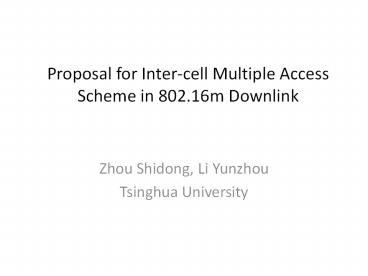Proposal for Inter-cell Multiple Access Scheme in 802.16m Downlink - PowerPoint PPT Presentation
Title:
Proposal for Inter-cell Multiple Access Scheme in 802.16m Downlink
Description:
In special cases, non-orthogonal allocation can also be included ... IEEE 802.16m uses OFDMA as the downlink intra-cell/sector multiple access scheme. ... – PowerPoint PPT presentation
Number of Views:72
Avg rating:3.0/5.0
Title: Proposal for Inter-cell Multiple Access Scheme in 802.16m Downlink
1
Proposal for Inter-cell Multiple Access Scheme in
802.16m Downlink
- Zhou Shidong, Li Yunzhou
- Tsinghua University
2
Content
- Non-orthogonal downlink resource allocation among
adjacent cells/sectors - Requirement of resource allocation criterion
3
Physical resource allocation of downlink
- Multiuser resource allocation within each cell
- Orthogonal allocation is highly recommended,
i.e., OFDMA, - both in time domain and frequency domain
- In special cases, non-orthogonal allocation can
also be included - Superposition coding for making full use of
near-far effect - Multi-cell resource allocation between adjacent
cells - Fractional frequency reuse can be applied
- At the cell edge, when traffic is light,
orthogonal allocation is highly recommended - At the cell edge, when traffic is heavy,
non-orthogonal resource allocation
(time/frequency reusing) among adjacent cells
will be included, e.g., CDMA, IDMA (interleaver
divistion multiple access)
4
Spectrum segmentation for downlink physical
resource allocation at the cell edge
- Different resource blocks (chunks) can be
allocated to adjacent cells - A separate segment of resource blocks is to be
assigned for the use of IDMA - This region can be further divided into subzones,
for different kinds of resource reuse - Benefit of IDMA
- Provide more users served at cell edge
- Provide higher data rate with joint decoding at
cell edge.
5
Requirement on non-orthogonal resource allocation
- When only single-user-decoding is applied with
IDMA, - no additional restriction of resource allocation
- When some of the terminals at cell edge need to
perform joint decoding with adjacent cell users - Resource allocation alignment is recommended
- For simple implementation
With resource alignment, joint decoding can be
local ones
Without resource alignment, joint decoding should
be global
6
Proposed SDD Text (1)
- x.x Downlink and Uplink Multiple Access Schemes
- IEEE 802.16m uses OFDMA as the downlink
intra-cell/sector multiple access scheme. - As for downlink inter-cell/sector multiple access
schemes, besides orthogonal(time/frequency)
multiple access among adjacent cells/sectors
where cell/sector edge traffic is not very heavy,
non-orthogonal multiple access shall be included
for heavy traffic as cell/sector edge, when
adjacent cells/sectors can use the same
frequency/time resource simultaneously. - As an additional non-orthogonal multiple access
technique, IDMA is used to support higher rate
for users at cell/sector edge.
7
Proposed SDD Text (2)
- x.x Downlink Physical Resource Allocation Unit
- When non-orthogonal downlink multiple access
among adjacent cells/sectors is to be applied for
downlink resource allocation, a segment for
non-orthogonal resource allocation shall be
defined, which is better to be aligned with
adjacent cells/sectors. The allocation of such
resource segment among users shall support
resource unit alignment among users from adjacent
cells/sectors which may share the resource.































